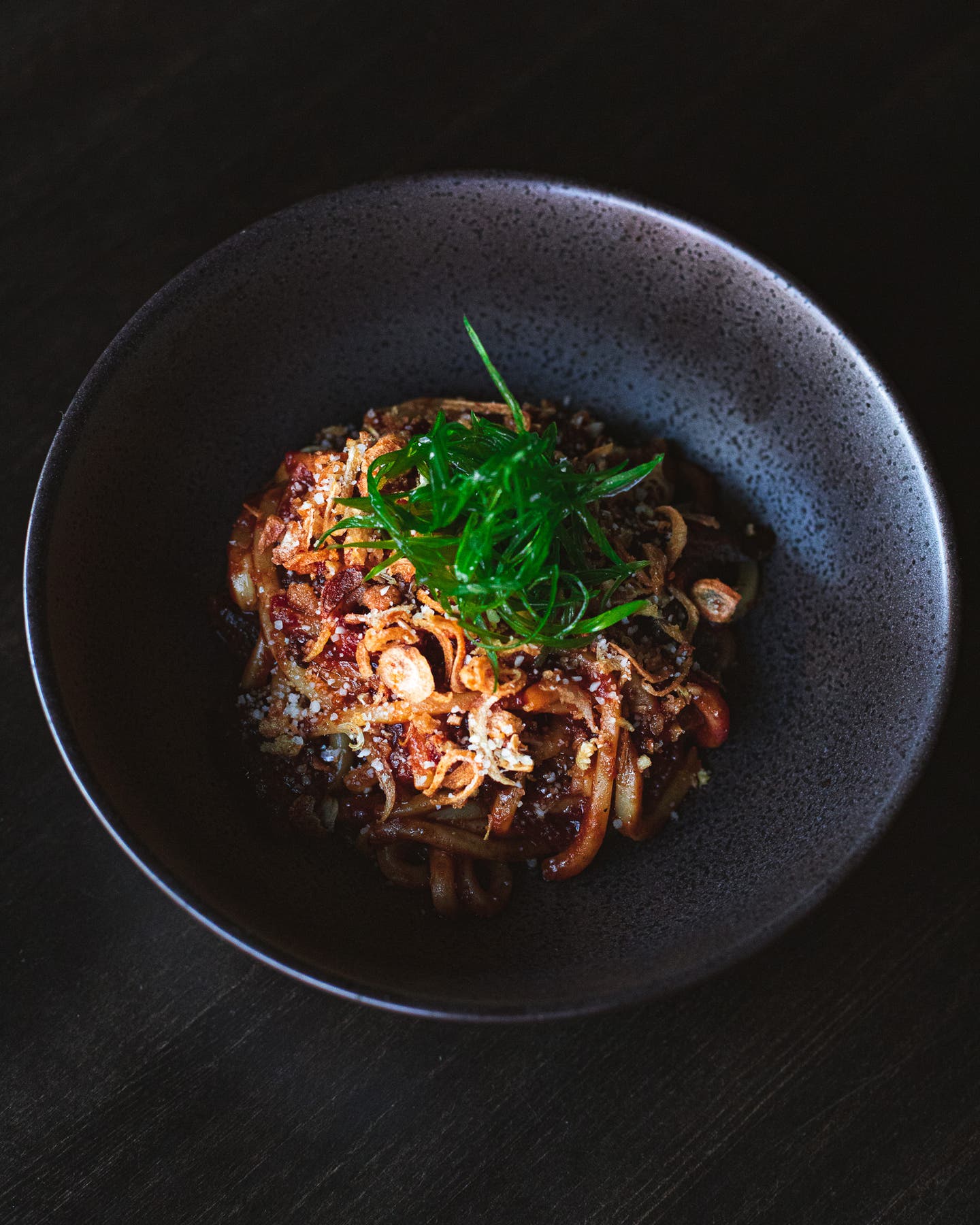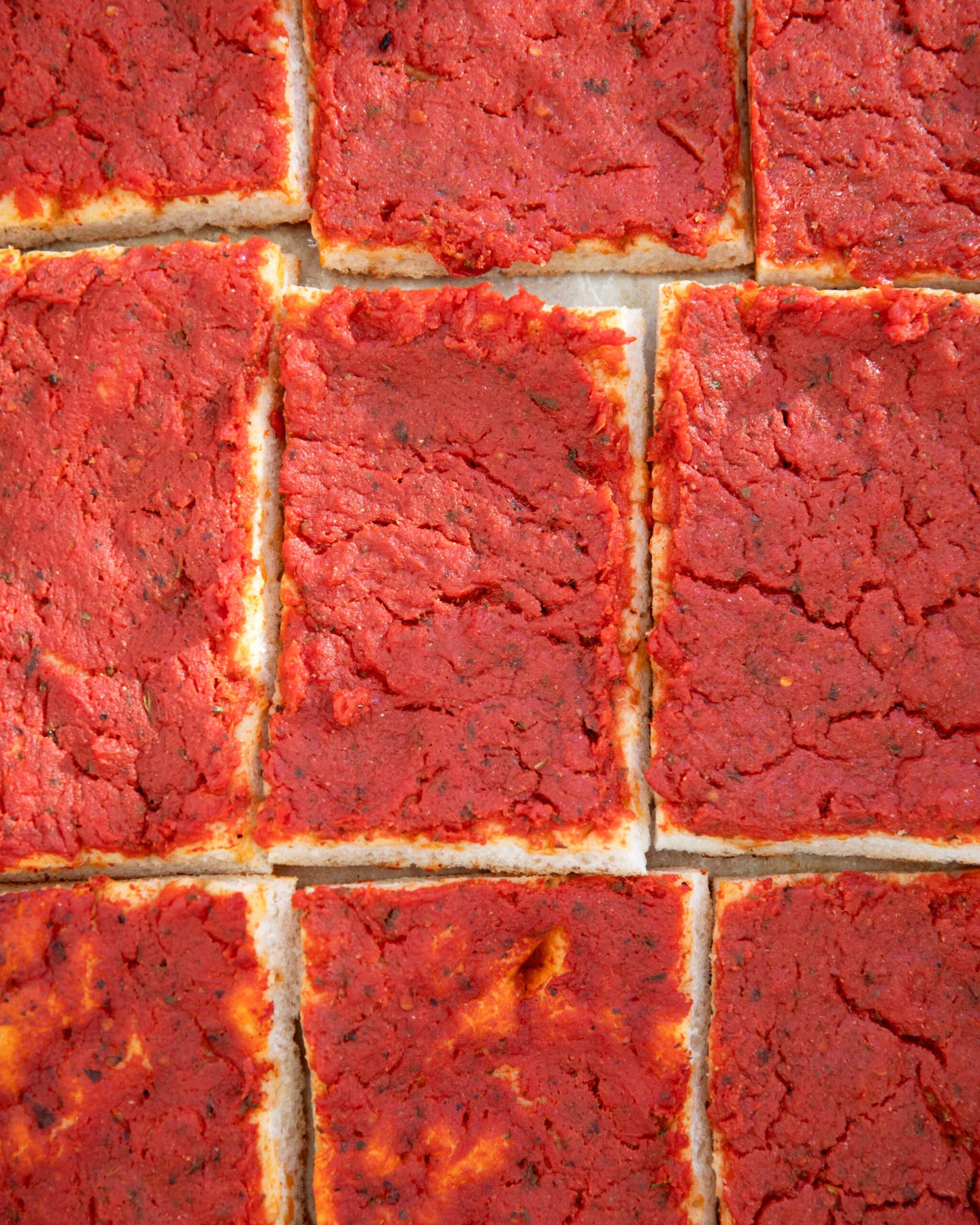Udon all’Amatriciana
Two masters of umami meet in this saucy, savory dish that borrows from both noodle-loving cuisines.
- Serves
4–6
- Time
3 hours

Japanese culture has long appreciated Italian food and culinary tradition. That enthusiasm spawned a category of cooking in the island country called wafu-Italian, which evolved from Japanese interpretations of the European nation’s cuisine (wafu translates as “Japanese-style”). Chef Robbie Felice, who owns the wafu-Italian restaurant Pasta Ramen in Montclair, New Jersey, created this udon all’amatriciana recipe as an homage to the symbiosis of the two cuisines.
The tomato sauce can be prepped ahead of time and stored in the fridge or freezer. (This recipe makes about six cups, but you only need one cup for the amatriciana. You can use the leftovers to make our favorite tomato recipes.) Use the tomato sauce to finish the amatriciana just before serving. Guanciale, which derives its name from the Italian word for cheek, is cured pork jowl and can be found in many Italian grocers. If you can’t find it, pancetta and bacon can pack a similarly umami-rich punch. Look for udon in any Asian grocer (Felice likes the Shirakiku Sanukiya brand). You can also find pre-made crispy garlic and crispy red onion at Asian grocers.
Featured in, “These Two Noodle-Loving Cultures Tangle Seamlessly on the Plate.” by Megan Zhang.
Ingredients
For the basic tomato sauce:
- ¼ cup extra-virgin olive oil
- 1 small white onion (8 oz.), finely chopped
- 10 garlic cloves, thinly sliced (⅓ cup)
- Two 28-oz. cans whole peeled San Marzano tomatoes
- 1 Tbsp. plus 1½ tsp. sugar
- 1½ tsp. kosher salt
For the amatriciana:
- 4 tsp. sesame oil
- 2 large red onions (10 oz.), each cut into 10 wedges
- 4½ oz. guanciale, cut into thin matchsticks (1 cup)
- 2 Tbsp. white miso
- 2 tsp. freshly ground black pepper
- Pinch crushed red chile flakes
- Pinch ichimi togarashi
- ¾ cup low-sodium chicken stock
- 1½ tsp. soy sauce
- Kosher salt
- Two 8-oz. packages fresh udon
- ⅔ cup (1½ oz.) finely grated Pecorino Romano, plus more for garnish
- Crispy garlic, for garnish
- Crispy red onion, for garnish
- Thinly sliced scallions, for garnish
Instructions
Step 1
Step 2
Step 3
- Make the basic tomato sauce: To a medium pot over medium heat, add the olive oil; when it’s hot and shimmering, add the onion and garlic and cook, stirring frequently, until the onions are translucent, 8–10 minutes. Add the canned tomatoes (including their juices), turn the heat to high, bring to a boil, then turn the heat down to maintain a gentle simmer. Cook, stirring occasionally, until thickened and chunky, about 2 hours. Turn off the heat, stir in the sugar and salt, and set aside.
- Make the amatriciana: To a wide pot over medium heat, add the sesame oil; when it’s hot and shimmering, add the red onion and cook, stirring frequently, until the onions begin to brown, 12–14 minutes. Add the guanciale and cook, stirring frequently, until brown and crispy, 6–8 minutes. Stir in the miso and continue cooking until the paste is slightly browned, about 2 minutes. Add the black pepper, chile flakes, togarashi, and 1 cup of the basic tomato sauce (reserving the rest for another use). Turn the heat up to medium-high, and, stirring continuously, bring the sauce up to a boil. Stir in the chicken stock and soy sauce, then remove from the heat, and set aside.
- Set a large pot of water over high heat and bring to a boil. Salt the water generously, add the udon, and cook according to the package instructions until the block of noodles separates into strands, about 2 minutes. Using a spider strainer or tongs, transfer the noodles to the pot of amatriciana sauce. Turn the heat under the sauce to medium-high and finish cooking the noodles, tossing gently, until just tender and evenly coated, 1–2 minutes. Add the pecorino, then turn off the heat and stir well until the cheese has melted into the sauce. Transfer to serving bowls, and garnish each with more pecorino, crispy garlic, crispy red onions, and scallions. Serve hot.
Keep Reading
Continue to Next Story










